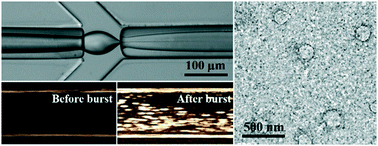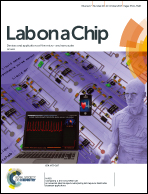Microfluidic production of nanoscale perfluorocarbon droplets as liquid contrast agents for ultrasound imaging†
Abstract
Liquid perfluorocarbon (PFC) nanodroplets may have a better chance to extravasate through inter-endothelial gaps (400–800 nm) into tumor interstitium for extravascular imaging, which holds promise as an innovative strategy for imaging-guided drug delivery, early diagnosis of cancer and minimally invasive treatment of cancer. Currently available emulsion technologies still face challenges in reducing droplet sizes from the microscale to the nanoscale. To control size and ensure monodispersity of PFC nanodroplets, we developed a flame-shaped glass capillary and polydimethylsiloxane (PDMS) hybrid device that creates a concentric flow of the dispersed phase enclosed by the focusing continuous phase at the cross-junction. Through adjustment of the pressure applied, a stable tip-streaming mode can be obtained for PFC nanodroplet generation. Using this device, we synthesized various kinds of PFC nanodroplets as small as 200 nm in diameter with polydispersity index (PDI) <0.04. Dynamic light scattering (DLS) and transmission electron microscopy (TEM) were carried out for the characterization of the PFC nanodroplets. Finally, ultrasound imaging was conducted to demonstrate that the liquid PFC nanodroplets can be used for enhancing the ultrasound contrast upon vaporization.



 Please wait while we load your content...
Please wait while we load your content...